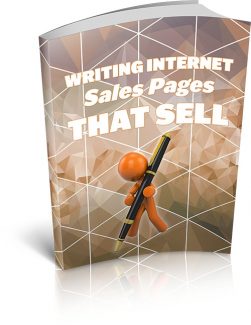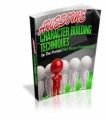 License Type: Master Resell Rights
License Type: Master Resell Rights  File Type: ZIP
File Type: ZIP
 SKU: 63261
SKU: 63261  Shipping: Online Download
Shipping: Online Download
Sample Content Preview
Writing Internet Sales Pages That Sell
GRAB THE HEADLINES
The first basic element of an effective Internet marketing (IM) sales page is the headline. Just like a newspaper sells based on the front-page headlines, your IM sales page is going to get viewers on the basis of the main headline. Thus, you have to be sure to make this as persuasive as possible while listing in one sentence the single biggest benefit your product or service has to offer to the potential customer.
FONT SIZE MATTERS
Whatever your headline, you want it to be written in the biggest font found anywhere on the sales page. That means that it is meant to grab attention, and using the size of the font this way really sets it apart. Don't be too creative on the font type, as you want to make it very easy to read; however, be very careful to make it the biggest text on the page, as that does matter.
USE A BIG TRIGGER
There are numerous psychological triggers that will produce an immediate reaction with your audience. You should study these triggers, understand the demographic you are marketing to, and then choose one that is more apt to appeal to your market segment. For instance, say you are selling a product that could have many competitors in the market. So, you want to make sure that whomever lands on your sales page that they order from you, rather than taking the time to scope out the competitors and compare offers. You find that your demographic consists of business people who are used to deadlines and want to get a good deal. So, you implement a time limited offer to trigger buying behavior now and make it uncomfortable for them to take the time to look elsewhere for fear of losing out on a great deal. In that case, you list your biggest benefit, but you also make it clear that the offer is only available for the next 12 hours or until the product is sold out.
THE THREE-HEADLINER STRATEGY
Some marketers like to make use of a three-headliner strategy. In this example, you have a pre-headline to introduce the main headline. It is not as big as the main headline and doesn't necessarily list the biggest benefit. It just sets the customer up to read the second, and main, headline. The second headline is the one with the biggest benefit and trigger. It should be a statement or offer that immediately provokes an emotional response. After that, there is a final headline that is much smaller and that gives any additional information to clarify the main headline. This approach works well and provides more space to be thorough with your main headline.
INTRODUCTION AND TYPES OF TRIGGERS
Every good news story starts with a hook, and your sales page will also want to implement this technique. A hook can be one or two sentences that really grab the imagination and attention of the reader. There is a real art to creating effective hooks, but mainly it is something that will cause the reader to pause slightly and that will trigger an emotional response. If the hook is effective, it does just what its namesake says: It hooks the reader into reading the rest of your sales page.
Let's be clear here. No one likes to spend a lot of time reading sales letters. Generally, a large number of people out there find reading to be a chore. So, you have to make it interesting and exciting. You have to get the reader to want to read the rest of the story. Without the hook, the headline isn't enough. You have to take into account the way people skim a story or sales page to decide whether it's worth reading thoroughly. First, they read the headline. If that grabs them, they will read the first few sentences. Then, they will most likely skip to the bullet points or the subheadings to decide whether to dive into the sales letter deeper. If your first few sentences are a bore, that's about the time you will lose that Web surfer to some other Internet marketer. You have to make those first few sentences count because that may be the only thing a visitor reads to decide whether to go on with your offer or not. That's why using psychological triggers to provoke a response is very, very important.
TYPES OF TRIGGERS
As a sales person, you have to know that people buy on impulse many times. They may give you a rational explanation after the sales is completed, but ultimately, much buying behavior is an emotional response to a particular marketing trigger. Some of the triggers you can use are:
- Ease of use If you've found a solution to a problem that seriously uncomplicates people's lives, you will get a lot of sales.
- Status If your demographic is wealthy, then they may be seeking status symbols to set themselves apart from common folk.
- Belonging People join all kinds of groups where they feel a sense of community or belonging. If you can tie your product or service to some group identity that is large and lucrative, you can get quite a number of sales using this trigger.
- Risk Aversion If your customer stands to lose by not taking you up on a time limited or quantity limited offer, they will bite to close the sale more often than not.
ESTABLISH CREDIBILITY
When someone visits a sales page, they may not have any idea who you are or why they should buy from you. In order to make a case that you are indeed trustworthy, you have to either list your credentials or get other people to vouch for you. There are a number of different ways you can convince the average visitor that you are a genuine businessperson and not just some Internet scam artist. Here are a few good ways to reduce the resistance to buy from you, simply because they don't quite know who you are or whether your business is legitimate.
FLAUNT YOUR CREDENTIALS
If you have degrees, teach seminars, written a book, or done anything that can establish a personal connection and authority on the subject you are selling, be sure to flaunt it. Nothing sells better than a person who is keenly involved in the field that they promote.
PROVIDE TESTIMONIALS
You can write up testimonials that others provide to you. Preferably, they should include real results, not just gushing admiration. In order to give them authenticity, ask permission from the person who offers the testimonial to reprint their quote with their full name. Adding a city and state also gives it more credibility.
POINT TO FAVORABLE REVIEWS
Did someone else give your products, service, or business a review? If it was favorable, post a link to it on your sales page so that they can see that you really are who you say you are and can provide what you say you do. If you don't want to post a link, quote the article and list the reference that gave you the review.
GIVE OUT CONTACT INFORMATION
This seems very simple, but many IM people bypass it for fear of being “too available.” You don't have to give out a physical address, but having a phone number or email address where people can reach you to ask pre-sales questions is good. It shows that you are an actual live person who is doing business online and not just some scam website.








